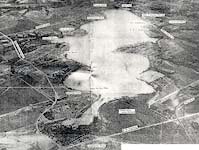 White Rock Lake began to collect silt from the day the dam was
completed. In 1933, a news article advocating dredging the lake
recalled that "we are able to look back to the days when the
lake extended a quarter of a mile north of the Northwest Highway."
Several years later, the first dredging of the lake got off to a
rocky start in 1937 (photo left).A
dredge was purchased by the city for $21,973 and named after Mayor
Joe Lawther (photo right). A few days after it began operations,
it sunk. Rumors flew about the drunkenness of the crew, but the
real cause was leaks in the hull. The dredge was raised, repaired
and dredging began again in
White Rock Lake began to collect silt from the day the dam was
completed. In 1933, a news article advocating dredging the lake
recalled that "we are able to look back to the days when the
lake extended a quarter of a mile north of the Northwest Highway."
Several years later, the first dredging of the lake got off to a
rocky start in 1937 (photo left).A
dredge was purchased by the city for $21,973 and named after Mayor
Joe Lawther (photo right). A few days after it began operations,
it sunk. Rumors flew about the drunkenness of the crew, but the
real cause was leaks in the hull. The dredge was raised, repaired
and dredging began again in 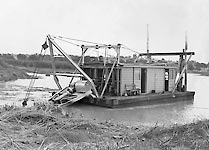 April 1938 and continued until February
1939 when operations were curtailed due to lack of funds. Shortly
after that, the dredge sank again. The third time was a charm and
the dredging operation continued for three years. The silt was used
to fill the swampy areas around the lake shore. The dredging project
added 90 acres at the north end of the lake and 60 acres at Dixon's
Branch Creek.
April 1938 and continued until February
1939 when operations were curtailed due to lack of funds. Shortly
after that, the dredge sank again. The third time was a charm and
the dredging operation continued for three years. The silt was used
to fill the swampy areas around the lake shore. The dredging project
added 90 acres at the north end of the lake and 60 acres at Dixon's
Branch Creek.
The
lake was dredged for the second time in 1955-56 during the drought.
The city did not have much money. The dredge cleaned up some on
the shallow water problems, then sank and rotted.
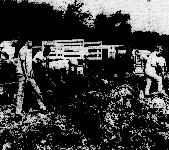 A
campaign to dredge the lake again began in the late 1960s. The lake
level was low in 1970 and the Park Department decided that one way
to help get rid of silt was to encourage people to haul it off (photo).
Park Director L. B. Houston said "They can remove it by buckets,
trucks, trailers, wheelbarrows or whatever. ...About two feet of
top soil is available in some areas, particularly on the north end
of the lake. Signs will be placed in strategic locations denoting
'Free Dirt.'"
A
campaign to dredge the lake again began in the late 1960s. The lake
level was low in 1970 and the Park Department decided that one way
to help get rid of silt was to encourage people to haul it off (photo).
Park Director L. B. Houston said "They can remove it by buckets,
trucks, trailers, wheelbarrows or whatever. ...About two feet of
top soil is available in some areas, particularly on the north end
of the lake. Signs will be placed in strategic locations denoting
'Free Dirt.'"
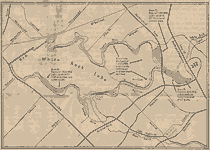 A
third dredging commenced in 1974 and was completed in seven months.
A few thousand cubic yards of silt were pumped to settling ponds
on the west side of White Rock Creek, north and south of the Mockingbird
Bridge (photo). The dog park is now on part of this landfill. The
rest of the silt was just pumped from the shallowest areas of the
lake to deeper areas through a spoil pipe running about 100 yards
from the position of the dredge.
A
third dredging commenced in 1974 and was completed in seven months.
A few thousand cubic yards of silt were pumped to settling ponds
on the west side of White Rock Creek, north and south of the Mockingbird
Bridge (photo). The dog park is now on part of this landfill. The
rest of the silt was just pumped from the shallowest areas of the
lake to deeper areas through a spoil pipe running about 100 yards
from the position of the dredge.
The contractor was supposed to achieve an average depth of 8 feet.
On several occasions, the dredging crew failed to move the spoil
pipe. At least three islands built up to within a foot or two of
the water surface. Sailors placed stakes on these navigation hazards
and forced a meeting with the City, the engineering firm and prime
contractor. The dredge had been removed by this time. The engineers
stoutly denied that there was a problem and refused to come out
and see the evidence.
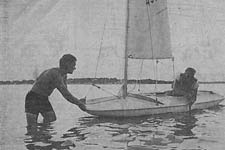 A
reporter for the Dallas Morning News agreed to cover the
story with a photographer, but his editor refused to allow him to
do the story. He referred the sailors to a reporter for the Dallas
Times Herald who had no problem with his editor. The Dallas
Times Herald published an article with this photo of a Butterfly
sailor (Bob Biegler) being pushed off a mud bank near Winfrey Point
by another sailor (John Diggins) standing in knee deep water. As
a result of the publicity, the contractor put a workboat back on
the lake which dragged a steel I-beam over the shallow areas until
they were deep enough for the sailboats.
A
reporter for the Dallas Morning News agreed to cover the
story with a photographer, but his editor refused to allow him to
do the story. He referred the sailors to a reporter for the Dallas
Times Herald who had no problem with his editor. The Dallas
Times Herald published an article with this photo of a Butterfly
sailor (Bob Biegler) being pushed off a mud bank near Winfrey Point
by another sailor (John Diggins) standing in knee deep water. As
a result of the publicity, the contractor put a workboat back on
the lake which dragged a steel I-beam over the shallow areas until
they were deep enough for the sailboats.
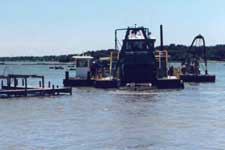
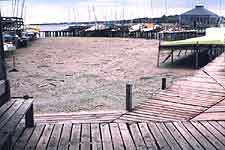
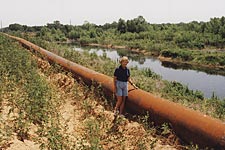
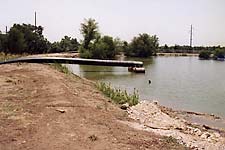
The most recent dredging (photos above) was completed in 1998.
All went well this time. The contractor
did a great job - completing the job ahead of schedule and removing
more silt than planned. The lake was dredged to a minimum depth
of 8 feet, north from a line between Winfrey Point and Jackson's
Point up to the Mockingbird Bridge. The spoils were pumped 17 miles
to an old gravel quarry in south Dallas County. A
dry summer combined with the dredging operation caused the water
level to drop to a point that sailors were unable to launch boats
from their davits by summer's end. Fall rains refilled
the lake and we were again enjoying the use of the entire lake.
